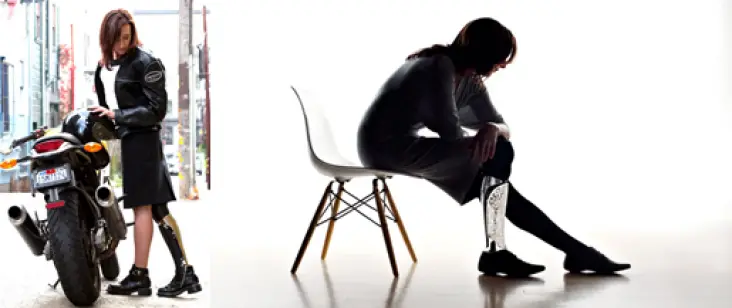
Guest post: The newest breakthrough in artificial limbs
Artificial limbs have come a long way in recent years. With limbs that can be controlled by slight eye movement the technology just keeps getting better, however this isn’t the only recent breakthrough concerning prosthesis.
In 2009, fashion designer Scott Summit was approached with a proposition: could he find a way of making prosthetic limbs more aesthetically pleasing whilst keeping them affordable? Scott believed that it was possible and over the last few years he has teamed up with a trained orthopaedic surgeon, Dr Trauner, to create some stunning and unique artificial limbs that not only allows amputees to keep their active lifestyles, but ‘turn their bodies into a sculpture’.
“I set out to create an option for an amputee that invites an individual personality and taste to play the dominant role in the design process. The goal is to transform a product from something that certain people need into something that they love.”
Scott produces these beautiful legs by combining the existing prosthetic with a cover known as a fairing. The word comes from motorcycles, whose fairings are shells that cover the workings to provide streamlining and shape to the motorcycle. Scott’s fairings in essence do the same thing. They create symmetry and shape whilst allowing the inner workings of the leg to work without interruption.
“I always wondered why it is, however, that certain fields cannot infuse both design and utility and artfully marry them to a more suitable outcome.”
The fairings are made using the latest in 3D scanning technology. The patients existing leg is scanned and then imported into a program called Geomagic Studio to be transferred into usable 3D data. The scans purpose is to give a higher level of symmetry when producing the bespoke design for the fairing and the prosthesis itself. This is vital for the posture and walking form of the patient as even the slightest irregularity in the length of a leg can cause back problems. Scanning can take less than a minute and then the client has a range of designs, patterns, templates and materials to choose from to customise their fairing to best suit their personality and taste.
“It’s unfortunate that people have had a product that’s such a major part of their lives that was so under designed”
Deborah, an amputee from a road accident in 2004, had a prosthetic made from bespoke innovations using Scott’s designs and said “Instead of trying to blend in and be like everyone else, now I really go out of my way to show off my leg”.
Once the design is completed on the computer, 3D CAD software is used to create the sculpture-like fairings. Each fairing is individually modular and designed to fit over the mechanical parts of the prosthesis without interference. Surprisingly this method is relatively cheap whereas customization usually involves more cost. The 3D printing industry has allowed the quality and customization of a leg to come without the long manufacturing process and the matching high price, the whole process can take up to three weeks.
This is a guest post written by Joseph Hill on behalf of Pannone, a law firm specializing in Personal Injury. To see more pictures of the stunning prosthetics made by Scott Summit and Dr Trauner click here.
This is very impressive. It will benifit so many people out there.